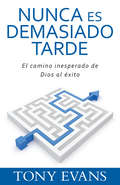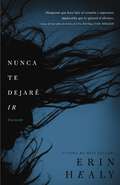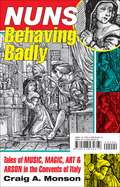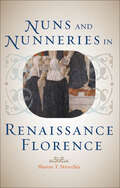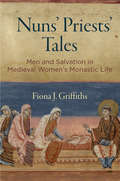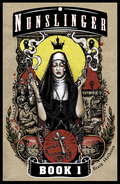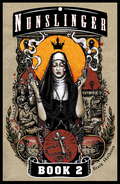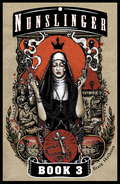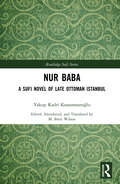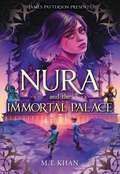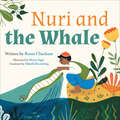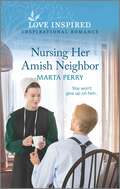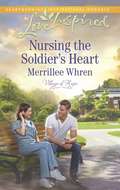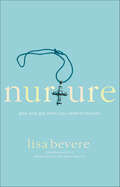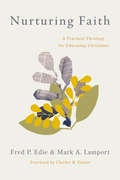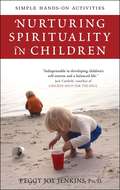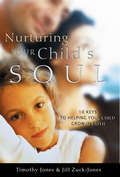- Table View
- List View
Nunca es demasiado tarde: El camino inesperado de Dios al éxito
by Tony EvansCuando muchos lectores cristianos piensan en los héroes de la Biblia, piensan en lo "buenos" que eran. Se olvidan de que... Rahab era una ramera; Jonás, un rebelde; Moisés, un asesino; Sara, una incrédula; Pedro, un apóstata; Ester, una diva; Sansón, un mujeriego; Jacob, un engañador. Y sin embargo, estos ocho hombres y mujeres forman parte de los héroes más famosos de la Biblia. Dr. Tony Evans utiliza estos personajes bíblicos importantes, cuyas acciones no fueron conformes al carácter de Dios, para ilustrar la verdad de que Dios se deleita en usar a las personas imperfectas que han fallado, pecado, o simplemente fracasado. Los lectores se sentirán alentados acerca de su propio caminar con Dios al entender que Él los está encaminando hacia el éxito, a pesar de las muchas imperfecciones que tienen y los errores que cometen. When many Christian readers think of the heroes of the Bible, they think about how "good" they were. They forget that... Rahab was a harlot. Jonah was a rebel. Moses was a murderer. Sarah was a doubter. Peter was an apostate. Esther was a diva. Samson was a player. Jacob was a deceiver. And yet these eight men and women are among the Bible's greatest heroes. Dr. Tony Evans uses these prominent Bible characters, whose actions or reactions were not consistent with God's character, to illustrate the truth that God delights in using imperfect people who have failed, sinned, or just plain blew it. Readers will be encouraged about their own walk with God as they come to understand that He has them, too, on a path to success, despite their many imperfections and mistakes.
Nunca estás solo: Confía en el milagro de la presencia y el poder de Dios
by Max LucadoEn Nunca estás solo, Max Lucado, el pastor y autor best seller del New York Times, te mostrará que eres más fuerte de lo que crees porque Dios está más cerca de lo que te das cuenta. Serás consolado por el Dios vivo, amoroso y hacedor de milagros que ni lo pensará dos veces antes de entrar en los matorrales espinosos de tu mundo para sacarte de allí.Cuando sentimos que la vida no es suficiente, ¿le importa a Dios? Cuando lo escucho decir «No», ¿tiene una respuesta? Cuando me enfrento a una avalancha de desafíos, ¿me ayudará? Cuando la vida se vuelve oscura y tormentosa, ¿se da cuenta? Cuando me enfrento al temor a la muerte, ¿me ayudará?La respuesta en los milagros que dan vida en el Evangelio de Juan es un rotundo sí.En este libro, Max Lucado te ayudará a:Darte cuenta de que Jesús está caminando contigo y levantándote de tus tormentas.Permanecer en la gracia de la cruz, el milagro de la tumba vacía, y la garantía del poder de la restauración.Creer que Dios es tu fuente de ayuda siempre presente.Reconocer que nunca estás sin esperanza o fuerza porque nunca, nunca, estás solo.Anhelamos a Alguien que nos acompañe en medio de los líos de la vida. Anhelamos creer en un Dios vivo, amoroso y hacedor de milagros que ni lo pensará dos veces antes de entrar en los matorrales espinosos de nuestro mundo para sacarnos de allí.Si este es tu deseo, echa un vistazo a las palabras de Juan y los milagros de Cristo y ve si no logran su objetivo deseado: «Para que ustedes crean que Jesús es el Cristo, el Hijo de Dios, y para que al creer en su nombre tengan vida» (Juan 20.31).Hoy, ármate de valor porque eres más fuerte de lo que crees, ya que Dios está más cerca de lo que crees.You Are Never AloneIn You Are Never Alone, Max Lucado, the pastor and New York Times best-selling author, will show you that you are stronger than you think because God is closer than you realize. You'll be comforted by the living, loving, miracle-working God who won't even think twice about entering the thorny bushes of your world to get you out.When we feel that life is not enough, does God care? When I hear Him say "No", does He have an answer? When I am faced with an avalanche of challenges, will He help me? When life gets dark and stormy, does He notice? When I am faced with the fear of death, will He help me?The answer in the life-giving miracles in John's Gospel is a resounding yes.In this book, Max Lucado will help you:Realize that Jesus is walking with you and lifting you up from your storms.Remain in the grace of the cross, the miracle of the empty tomb, and the assurance of the power of restoration.Believe that God is your ever-present source of help.Recognize that you are never without hope or strength because you are never, ever, alone.We long for Someone to be with us in the midst of life's troubles. We long to believe in a living, loving, miracle-working God who will not even think twice about entering the thorny bushes of our world to get us out.If this is your desire, take a look at the words of John and the miracles of Christ and see if they do not achieve their desired goal: "That you may believe that Jesus is the Christ, the Son of God, and that by believing in his name you may have life" (John 20:31).Today, take courage because you are stronger than you think, because God is closer than you think.
Nunca te dejaré ir
by Erin HealyDespués de perderlo todo, Lexi se mantiene aferrada a su hija, pero el infierno decide hacerla perder el control. Han pasado siete años desde que los desastres azotaron a su familia. A duras penas, Lexi lo ha sobrellevado todo. Pero ya no puede más. El esposo que la abandonó ha regresado al pueblo para ver a su hija, Molly. El descarado asesino de su hermana está a punto de conseguir la libertad condicional. Un indeseable viejo amigo reclama el pago de deudas sobre las que Lexi no sabía nada y no puede pagar. Y algo más está pasando algo que siente pero que no puede explicarse. Un giro peligroso entre esta realidad y la otra. Una lucha de poder entre fuerzas que sobrepasan su imaginación. Una novela inusual que logrará satisfacer a una amplia gama de lectores, No te dejaré ir explora todo lo que se pone en juego en el pequeño espacio entre el cielo y la tierra. Mientras el enemigo aumenta cada vez más su control alrededor de Lexi, ella deberá decidir a qué vale la pena aferrarse realmente. "Te mantiene pegado a cada página hasta el final" - Tosca Lee, autora de Havah: The Story of Eve
Nuns Behaving Badly: Tales of Music, Magic, Art, and Arson in the Convents of Italy
by Craig A. MonsonWitchcraft. Arson. Going AWOL. Some nuns in sixteenth- and seventeenth-century Italy strayed far from the paradigms of monastic life. Cloistered in convents, subjected to stifling hierarchy, repressed, and occasionally persecuted by their male superiors, these women circumvented authority in sometimes extraordinary ways. But tales of their transgressions have long been buried in the Vatican Secret Archive. That is, until now. In Nuns Behaving Badly, Craig A. Monson resurrects forgotten tales and restores to life the long-silent voices of these cloistered heroines. Here we meet nuns who dared speak out about physical assault and sexual impropriety (some real, some imagined). Others were only guilty of misjudgment or defacing valuable artwork that offended their sensibilities. But what unites the women and their stories is the challenges they faced: these were women trying to find their way within the Catholicism of their day and through the strict limits it imposed on them. Monson introduces us to women who were occasionally desperate to flee cloistered life, as when an entire community conspired to torch their convent and be set free. But more often, he shows us nuns just trying to live their lives. When they were crossed—by powerful priests who claimed to know what was best for them—bad behavior could escalate from mere troublemaking to open confrontation. In resurrecting these long-forgotten tales and trials, Monson also draws attention to the predicament of modern religious women, whose “misbehavior”—seeking ordination as priests or refusing to give up their endowments to pay for priestly wrongdoing in their own archdioceses—continues even today. The nuns of early modern Italy, Monson shows, set the standard for religious transgression in their own age—and beyond.
Nuns and Nunneries in Renaissance Florence
by Sharon T. StrocchiaWinner, Helen and Howard R. Marraro Prize, American Catholic Historical AssociationThe 15th century was a time of dramatic and decisive change for nuns and nunneries in Florence. In the course of that century, the city’s convents evolved from small, semiautonomous communities to large civic institutions. By 1552, roughly one in eight Florentine women lived in a religious community. Historian Sharon T. Strocchia analyzes this stunning growth of female monasticism, revealing the important roles these women and institutions played in the social, economic, and political history of Renaissance Florence. It became common practice during this time for unmarried women in elite society to enter convents. This unprecedented concentration of highly educated and well-connected women transformed convents into sites of great patronage and social and political influence. As their economic influence also grew, convents found new ways of supporting themselves; they established schools, produced manuscripts, and manufactured textiles. Strocchia has mined previously untapped archival materials to uncover how convents shaped one of the principal cities of Renaissance Europe. She demonstrates the importance of nuns and nunneries to the booming Florentine textile industry and shows the contributions that ordinary nuns made to Florentine life in their roles as scribes, stewards, artisans, teachers, and community leaders. In doing so, Strocchia argues that the ideals and institutions that defined Florence were influenced in great part by the city’s powerful female monastics. Nuns and Nunneries in Renaissance Florence shows for the first time how religious women effected broad historical change and helped write the grand narrative of medieval and Renaissance Europe. The book is a valuable text for students and scholars in early modern European history, religion, women’s studies, and economic history.
Nuns and Nunneries in Renaissance Florence
by Sharon T. StrocchiaAn analysis of Renaissance Florentine convents and their influence on the city’s social, economic, and political history.The 15th century was a time of dramatic and decisive change for nuns and nunneries in Florence. That century saw the city’s convents evolve from small, semiautonomous communities to large civic institutions. By 1552, roughly one in eight Florentine women lived in a religious community. Historian Sharon T. Strocchia analyzes this stunning growth of female monasticism, revealing the important roles these women and institutions played in the social, economic, and political history of Renaissance Florence.It became common practice during this time for unmarried women in elite society to enter convents. This unprecedented concentration of highly educated and well-connected women transformed convents into sites of great patronage and social and political influence. As their economic influence also grew, convents found new ways of supporting themselves; they established schools, produced manuscripts, and manufactured textiles.Using previously untapped archival materials, Strocchia shows how convents shaped one of the principal cities of Renaissance Europe. She demonstrates the importance of nuns and nunneries to the booming Florentine textile industry and shows the contributions that ordinary nuns made to Florentine life in their roles as scribes, stewards, artisans, teachers, and community leaders. In doing so, Strocchia argues that the ideals and institutions that defined Florence were influenced in great part by the city’s powerful female monastics.Winner, Helen and Howard R. Marraro Prize, American Catholic Historical Association“Strocchia examines the complex interrelationships between Florentine nuns and the laity, the secular government, and the religious hierarchy. The author skillfully analyzes extensive archival and printed sources.” —Choice
Nuns' Priests' Tales: Men and Salvation in Medieval Women's Monastic Life (The Middle Ages Series)
by Fiona J. GriffithsDuring the Middle Ages, female monasteries relied on priests to provide for their spiritual care, chiefly to celebrate Mass in their chapels but also to hear the confessions of their nuns and give last rites to their sick and dying. These men were essential to the flourishing of female monasticism during the eleventh and twelfth centuries, yet they rarely appear in scholarly accounts of the period. Medieval sources are hardly more forthcoming. Although medieval churchmen consistently acknowledged the necessity of male spiritual supervision in female monasteries, they also warned against the dangers to men of association with women. Nuns' Priests' Tales investigates gendered spiritual hierarchies from the perspective of nuns' priests—ordained men (often local monks) who served the spiritual needs of monastic women.Celibacy, misogyny, and the presumption of men's withdrawal from women within the religious life have often been seen as markers of male spirituality during the period of church reform. Yet, as Fiona J. Griffiths illustrates, men's support and care for religious women could be central to male spirituality and pious practice. Nuns' priests frequently turned to women for prayer and intercession, viewing women's prayers as superior to their own, since they were the prayers of Christ's "brides." Casting nuns as the brides of Christ and adopting for themselves the role of paranymphus (bridesman, or friend of the bridegroom), these men constructed a triangular spiritual relationship in which service to nuns was part of their dedication to Christ. Focusing on men's spiritual ideas about women and their spiritual service to them, Nuns' Priests' Tales reveals a clerical counter-discourse in which spiritual care for women was depicted as a holy service and an act of devotion and obedience to Christ.
Nuns' Priests' Tales: Men and Salvation in Medieval Women's Monastic Life (The Middle Ages Series)
by Fiona J. GriffithsDuring the Middle Ages, female monasteries relied on priests to provide for their spiritual care, chiefly to celebrate Mass in their chapels but also to hear the confessions of their nuns and give last rites to their sick and dying. These men were essential to the flourishing of female monasticism during the eleventh and twelfth centuries, yet they rarely appear in scholarly accounts of the period. Medieval sources are hardly more forthcoming. Although medieval churchmen consistently acknowledged the necessity of male spiritual supervision in female monasteries, they also warned against the dangers to men of association with women. Nuns' Priests' Tales investigates gendered spiritual hierarchies from the perspective of nuns' priests—ordained men (often local monks) who served the spiritual needs of monastic women.Celibacy, misogyny, and the presumption of men's withdrawal from women within the religious life have often been seen as markers of male spirituality during the period of church reform. Yet, as Fiona J. Griffiths illustrates, men's support and care for religious women could be central to male spirituality and pious practice. Nuns' priests frequently turned to women for prayer and intercession, viewing women's prayers as superior to their own, since they were the prayers of Christ's "brides." Casting nuns as the brides of Christ and adopting for themselves the role of paranymphus (bridesman, or friend of the bridegroom), these men constructed a triangular spiritual relationship in which service to nuns was part of their dedication to Christ. Focusing on men's spiritual ideas about women and their spiritual service to them, Nuns' Priests' Tales reveals a clerical counter-discourse in which spiritual care for women was depicted as a holy service and an act of devotion and obedience to Christ.
Nunslinger 1
by Stark HolbornThe year is 1864. Sister Thomas Josephine is on her way from St Louis, Missouri, to Sacramento, California. During the course of her journey, however, she'll find that her faith requires her to take off her wimple and pick up a gun. Innocent Visitandine nun Sister Thomas Josephine wants nothing more than an adventure-free journey out west. But adventure is what she'll get - and heaps of it - when she's taken hostage by a desperate outlaw on the Laramie Plains of Wyoming. Before long she'll find herself torn between two men, the handsome Union Army Lieutentant Thomas F. Carthy and the mysterious drifter Abraham C. Muir. And soon, one of these men will be staring down the barrel of her gun. In this exclusive, free, all-new ebook, you’ll meet Sister Thomas Josephine, the innocent Visitandine nun, and travel along the overland trail with her as she meets varmints and scallywaygs galore. Free for a very limited time only, Nunslinger Book 1 is the first in an extraordinary new series that will publish serially throughout 2014. Don’t miss a single instalment – preorder Sister Thomas Josephine’s adventures today!
Nunslinger 1
by Stark HolbornThe year is 1864. Sister Thomas Josephine is on her way from St Louis, Missouri, to Sacramento, California. During the course of her journey, however, she'll find that her faith requires her to take off her wimple and pick up a gun. Innocent Visitandine nun Sister Thomas Josephine wants nothing more than an adventure-free journey out west. But adventure is what she'll get - and heaps of it - when she's taken hostage by a desperate outlaw on the Laramie Plains of Wyoming. Before long she'll find herself torn between two men, the handsome Union Army Lieutentant Thomas F. Carthy and the mysterious drifter Abraham C. Muir. And soon, one of these men will be staring down the barrel of her gun. In this exclusive, free, all-new ebook, you?ll meet Sister Thomas Josephine, the innocent Visitandine nun, and travel along the overland trail with her as she meets varmints and scallywaygs galore. Free for a very limited time only, Nunslinger Book 1 is the first in an extraordinary new series that will publish serially throughout 2014. Don?t miss a single instalment ? preorder Sister Thomas Josephine?s adventures today!
Nunslinger 2: The Good, the Bad and the Penitent
by Stark HolbornThe year is 1864. Sister Thomas Josephine is on her way from St Louis, Missouri, to Sacramento, California. During the course of her journey, however, she'll find that her faith requires her to take off her wimple and pick up a gun...NUNSLINGER Book II relates the true tale of how Sister Thomas Josephine of St Louis, Missouri, comes to be wanted for murder and faces the hangman's noose in Carson City, Nevada. Only by relying on the help of an armload of fancy women and a wily old friend does she have any hope for escape!
Nunslinger 2: The Good, the Bad and the Penitent
by Stark HolbornThe year is 1864. Sister Thomas Josephine is on her way from St Louis, Missouri, to Sacramento, California. During the course of her journey, however, she'll find that her faith requires her to take off her wimple and pick up a gun...NUNSLINGER Book II relates the true tale of how Sister Thomas Josephine of St Louis, Missouri, comes to be wanted for murder and faces the hangman's noose in Carson City, Nevada. Only by relying on the help of an armload of fancy women and a wily old friend does she have any hope for escape!
Nunslinger 3: A Pilgrim and a Stranger
by Stark HolbornThe year is 1864. Sister Thomas Josephine is on her way from St Louis, Missouri, to Sacramento, California. During the course of her journey, however, she'll find that her faith requires her to take off her wimple and pick up a gun...NUNSLINGER Book III finds Sister Thomas Josephine, now a fugitive from the law, racing through the harsh Sierra Nevada winter for the Mexican border. Hard on her heels is an old enemy... with a grudge the size of Texas. And she knows that if the cold doesn't kill her, he will.
Nunslinger 3: A Pilgrim and a Stranger
by Stark HolbornThe year is 1864. Sister Thomas Josephine is on her way from St Louis, Missouri, to Sacramento, California. During the course of her journey, however, she'll find that her faith requires her to take off her wimple and pick up a gun...NUNSLINGER Book III finds Sister Thomas Josephine, now a fugitive from the law, racing through the harsh Sierra Nevada winter for the Mexican border. Hard on her heels is an old enemy... with a grudge the size of Texas. And she knows that if the cold doesn't kill her, he will.
Nunsuch
by Candida LundToday the term "sister" implies community. These wonderful stories show all aspects of community life--from sublime to ridiculous.
Nur Baba: A Sufi Novel of Late Ottoman Istanbul (Routledge Sufi Series)
by Yakup Kadri KaraosmanoğluThis first-ever English translation of Nur Baba – a classic of modern Turkish literature written by Yakup Kadri Karaosmanoğlu – offers a unique window into Sufi lodges, social dilemmas, and intellectual life in early twentieth-century Istanbul. Inspired by Karaosmanoğlu’s personal experiences with Islamic mystical orders, it is a story of illicit romance and spiritual inquiry, depicting a colourful lodge of Sufi dervishes led by a charismatic, yet morally suspect, spiritual master named Nur Baba. The plot follows his attempts to seduce an attractive married woman from an elite family and recounts her dramatic experiences in the life of a Sufi community. The setting shuttles between the grand mansions of Istanbul’s elite families and a Sufi lodge where rich and poor intermingle. Exploring questions of gender, morality, and religious bias throughout, it captures the zeitgeist of early twentieth-century modernist thinkers who criticised Sufism for impeding social progress and debated the public roles of women in a rapidly modernising society. Alongside the editor’s meticulous translation, the volume includes a scholarly introduction, maps, and images, as well as explanatory footnotes that will aid both students and scholars alike. The novel will be of particular interest to those studying world literature, Sufi studies, and Ottoman-Turkish history.
Nura and the Immortal Palace
by M. T. KhanAru Shah and the End of Time meets Studio Ghibli&’s Spirited Away in this mesmerizing portal fantasy that takes readers into the little-known world of Jinn.Nura longs for the simple pleasure of many things—to wear a beautiful red dupatta or to bite into a sweet gulab. But with her mom hard at work in a run-down sweatshop and three younger siblings to feed, Nura must spend her days earning money by mica mining. But it&’s not just the extra rupees in her pocket Nura is after. Local rumor says there&’s buried treasure in the mine, and Nura knows that finding it could change the course of her family&’s life forever.Her plan backfires when the mines collapse and four kids, including her best friend, Faisal, are claimed dead. Nura refuses to believe it and shovels her way through the dirt hoping to find him. Instead, she finds herself at the entrance to a strange world of purple skies and pink seas—a portal to the opulent realm of jinn, inhabited by the trickster creatures from her mother&’s cautionary tales. Yet they aren&’t nearly as treacherous as her mother made them out to be, because Nura is invited to a luxury jinn hotel, where she&’s given everything she could ever imagine and more. But there&’s a dark truth lurking beneath all that glitter and gold, and when Nura crosses the owner&’s son and is banished to the working quarters, she realizes she isn&’t the only human who&’s ended up in the hotel&’s clutches. Faisal and the other missing children are there, too, and if Nura can&’t find a way to help them all escape, they&’ll be bound to work for the hotel forever. Set in a rural industrial town in Pakistan and full of hope, heart, and humor, Nura and the Immortal Palace is inspired by M.T. Khan&’s own Pakistani Muslim heritage.
Nuri and the Whale
by Ronit Chacham“They say he met the King of the Sea, who taught him something important.” “And it all happened because he fed a fish!” “And it all happened because he shared what little he had.” Every day young Nuri makes his way to the sea shore to eat some bread and throw a piece into the waves. He does so because his father told him to “cast your bread on the water”. Even though Nuri can’t remember the second part of that beloved saying, but he follows his father’s advice and generously feeds the fish in the sea. One day, Nuri slips and falls into the water where he meets the fish he had been feeding. As Nuri marvels at the treasures hidden beneath the waves, the fish takes him to the bottom of the sea. There, Nuri meets Whisewhale, the King of the Sea. Wisewhale teaches him something important about the saying his father passed on to him all those years ago. This will change Nuri’s life forever, he just doesn’t know it yet. Told in beautiful prose, this heartfelt story is inspired by the Hebrew Bible verse, “Cast your bread on the water, and one day it will come back to you.” - Kohelet (Ecclesiastes) 11:1. Through moving and uplifting encounters, Nuri teaches readers the value of kindness and the importance of being generous even when you don’t have much yourself. This is a simple message that has a big impact as we see Nuri grow to become surrounded by the love that blossomed as a result of his generosity. Accompanied by magical and colorful illustrations that bring the characters to life, young readers will be captivated by the illustrator’s unique style. The perfect bedtime story for 4 to 8 year olds.
Nursing Her Amish Neighbor (Brides of Lost Creek #6)
by Marta PerryHealing his physical wounds is just the beginning… Seeking a break from her nursing duties, Miriam Stoltzfus returns home to Lost Creek—and encounters her most difficult patient yet. Her childhood neighbor, Matthew King, is suffering after an accident left him injured and his younger brother dead. But he doesn&’t want anyone&’s help. Can Miriam guide him through his grief to prove he&’s still the strong, confident man she remembers?From Love Inspired: Uplifting stories of faith, forgiveness and hope.Brides of Lost Creek Book 1: Second Chance Amish BrideBook 2: The Wedding Quilt BrideBook 3: The Promised Amish BrideBook 4: The Amish Widow's HeartBook 5: A Secret Amish CrushBook 6: Nursing Her Amish Neighbor
Nursing the Soldier's Heart
by Merrillee WhrenLoving the Soldier Nurse Kirsten Bailey places her family above all else. She refuses to give former army medic Brady Hewitt any leeway for being weeks late in visiting his ill grandmother. But Brady has a good excuse, and he's eager to show the pretty nurse that first impressions aren't always right. While working with Brady to care for his grandmother and two orphaned boys, Kirsten realizes that his charm and kindness aren't an act. But Kirsten plans on doing missionary work abroad, and she's determined not to fall for the engaging soldier. Could the man she once dismissed be the one to make her stay forever?
Nursing the Spirit: Care, Public Life, and the Dignity of Vulnerable Strangers
by Don GrantIllness and death have always raised profound spiritual concerns. However, today most people experience suffering and treatment in hospitals and other impersonal, bureaucratic facilities whose employees are expected to follow scientific, rationalized norms of behavior. How do professional caregivers—the nurses and other workers who tend to patients—navigate between science and spirituality?Don Grant investigates the subtle ways that nurses at an academic medical center incorporate spirituality into their care work. Based on extensive fieldwork and an in-depth survey on spirituality, this book finds that many nurses see themselves as responsible for not only patients’ physical health but also their spiritual well-being. They believe they are able to reconcile science and spirituality through storytelling and claim that they can provide more spiritual care than chaplains. However, nurses rarely talk about religion among themselves because they are concerned that their colleagues are uncomfortable discussing spirituality. Nevertheless, by seeking to honor patients’ ultimate worth as human beings, many nurses are able to instantiate spiritual values of care.Grant interweaves his experiences as a hospital volunteer chaplain and a living liver-transplant donor with empirical analyses of nurses’ spiritual work. Developing a new understanding of the social significance of religion, Nursing the Spirit recasts the intersection of science and spirituality by centering the perspectives of the people who provide care.
Nurture: Give and Get What You Need to Flourish
by Lisa BevereNurture (verb): 1. To give tender care and protection. 2. To encourage to grow, develop, thrive, and be successful.This beautifully describes what God's daughters so desperately need. In this heartfelt work, Lisa explains how women of all ages must awaken and restore their capacity to give and receive nurture. The need for this indelible force is far more urgent than we know. Is it possible we are too busy surviving to assure that the vulnerable among us thrive? Are we too guarded, wounded, and afraid to open our lives to the nurture of others? What can be done to reestablish this language of the feminine heart? It is time women are healed and empowered. If you have never experienced nurture, this is your season. Lisa's stirring message shows you how to make these vital heart connections. We need each other's comfort and assurance as we define ourselves, find our voice, and begin to fulfill God's purpose on Earth. In Lisa's own words: "There is such a resonance in my spirit . . . this is in fact our season to grow, develop, and thrive. Heaven is passionately and purposefully reconnecting with our wounded, war-torn earth and the people who inhabit her. In this season I believe the daughters of God will prove integral agents. Nurture is not expensive-it is expansive. The life of everyone enlarges when it is added. As this happens, we will cease to merely function-we will indeed flourish."
Nurturing Faith: A Practical Theology for Educating Christians
by Fred P. Edie Mark A. LamportFaith left on rocky soil withers. But faith nurtured in the good soil of Christian teaching, formation, and mentorship grows to maturity and yields thriving community. Educational ministries are so often where this happens—where the desires of the human heart are shaped toward a love for God, a love for one&’s neighbor, and a love for the world. In this comprehensive guide to educational ministries in the twenty-first century, Fred Edie and Mark Lamport explore how church leaders and others involved in Christian education can nurture a robust, cruciform faith within their communities. When discussing strategies and goals, Edie and Lamport consider a range of contexts and a variety of related fields that might give insight into educational ministry: theology, pedagogy, philosophy, social science, and more. Those working with any age group—children, adolescents, and adults—will find a relevant discussion of key underlying theological themes, a guide to concrete practices, and indispensable help in navigating shifting cultural dynamics. Exceedingly practical and consistent with the teachings of the gospel, the wisdom in this book will speak to all who long to foster discipleship in their church, school, or missional community. Key FeaturesA &“Road Map&” at the beginning of each chapter concisely introduces the chapter&’s topic and essential themes.Sidebars throughout the text provide deeper insight into particular important or nuanced concepts.Discussion questions at the end of each chapter facilitate further reflection, especially in conversation with others.Suggestions for further reading are provided at the end of each chapter for those interested in exploring the chapter&’s ideas in greater depth.Concluding the book is a series of afterwords from experts in the field of Christian educational ministries: Martyn Percy, Almeda Wright, Craig Dykstra, Kirsten Oh, Elizabeth DeGaynor, and Thomas Groome.
Nurturing Spirituality in Children
by Peggy Joy JenkinsThe greatest gifts that a child can receive are an opened mind, a caring heart, and ignited creativity. This fully expanded, illustrated edition of Nurturing Spirituality in Children includes sixty-two simple and thought-provoking lessons that can be shared with children in less than ten minutes each. The lessons are easy to prepare and understand; they use commonly available materials and complement a wide variety of religious perspectives. Children who develop a healthy balance of mind and spirit are better able to respond to life's challenges when given the tools to think and discover for themselves. Dr. Jenkins gives scores of age-appropriate activities that help children learn empathy, trust, forgiveness, growth, and inner peace.
Nurturing Your Child's Soul
by Timothy JonesMany of us worry about our kids getting pulled under by our culture's negative currents. We try to shout over the roar of media blitzes, misguided values in the schools, and peer pressure. And we wonder how to raise faithful children.For parents who sometimes feel they haven't done enough, Jones provides ideas for taking small steps toward communication and intimacy, showing you how to take advantage of teachable moments by fully "focusing on the present."
